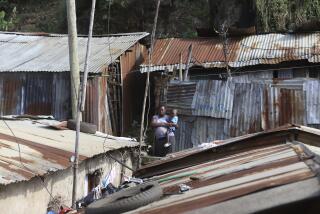Observers See Mammoth Task in Rebuilding Shattered Economy
- Share via
NAIROBI, Kenya — This East African nation, renowned for its spectacular vistas and wildlife, is facing one of the worst economic crises of its history. Unemployment has skyrocketed. Rationing of power and water has become the norm. Export earnings are down. Thousands of small businesses have shut their doors.
“You can certainly see the economic climate is not very good,” said Lucy Mulli, a researcher at the Institute for Security Studies in Pretoria, South Africa. “If you look at the most basic level, you can see that even the artisans are not able to carry on.”
Add to this the reality that millions of Kenyans face drought-related famine, and analysts believe the prospects for Kenya are dire.
The government of President Daniel Arap Moi is counting on foreign donors to help lift it out of this quagmire. On Wednesday, he appealed for $148 million in new assistance. But economic observers say the key to aid lies in Kenya’s getting its poorly managed house in order--a task some analysts doubt it can achieve.
“A combination of unfavorable macroeconomic fundamentals, dysfunctional institutions, collapsed infrastructure, lack of donor funds and low private-sector confidence will continue to depress overall economic activity,” the Economist Intelligence Unit, a London-based business information newsletter, said in its first quarterly report on Kenya for the year.
Relief workers confirm that the food shortage could trigger a humanitarian catastrophe.
“The current situation is indeed grave,” said Brenda Barton, a spokeswoman for the U.N. World Food Program, noting that more than one in eight Kenyans out of a population of 27.8 million will need food assistance from now until the end of the year.
Barton said the WFP has requested $131 million from foreign donors to feed the 3.3 million in need, compared with the $43 million it appealed for to feed 2.7 million Kenyans between Feb. 1 and June 30. The increase was needed partly because more people now rely solely on food aid to survive, Barton said.
Drought is being blamed for the food crisis. Long periods of low rainfall have killed off livestock and devastated harvests. The dry spell also is being blamed for the government’s recent introduction of power rationing 12 hours a day, six days a week--which is expected to last six to nine months, or until there is enough water to fill the local dams. Water for homes and businesses, already in short supply, is being further limited.
The enhanced rationing is expected to force the formal industrial sector to operate 50% below capacity, triggering a further surge in unemployment, while many self-employed small-businesspeople have been forced to close down.
“Right now, I am out of business because there is no power,” said Catherine Kanyatta, 38, who owns a hair salon in a working-class neighborhood here in the capital. “I cannot attend to any of my customers.”
Mohammed Masiga, 34, who runs a secretarial bureau, has been forced to lay off three of his four employees. The remaining staff member has resorted to typing documents on a manual typewriter. “The government should look for ways to save us from this situation,” Masiga said. “They should give us power during the daytime so that we can run our businesses. We are ready to stay without power at night in our homes.”
Critics of the government say Moi’s administration should stop blaming the weather for the country’s woes, because this is not the first time that the rain has failed to come, and the food situation has been tenuous since 1992, the last time Kenya suffered such a crisis.
“The claim of being caught unawares is completely false,” Sam Mwale, a Nairobi-based public policy analyst, wrote in a recent commentary in a local newspaper. “There is compelling evidence to show that the government should have more than prepared for the current situation, and in fact, there was really no need for a crisis.”
Despite all this, the government recently set an ambitious growth target of 2.1%.
Officials are banking on the anticipated release of $220 million in donor aid money--frozen since 1997--to help achieve that goal.
But analysts say that relying on donor handouts and praying for rain will go only so far. While the government tries to clean up its act, citizens will have to do their part.
“This is the point where Kenyans will need to put down their feet and say, ‘We are going to work, and we are going to develop our country,’ ” researcher Mulli said. “The international community is not going to get us out of the situation we’re in.”
*
Samuel Hinga Mwangi of The Times’ Nairobi Bureau contributed to this report.
More to Read
Sign up for Essential California
The most important California stories and recommendations in your inbox every morning.
You may occasionally receive promotional content from the Los Angeles Times.














